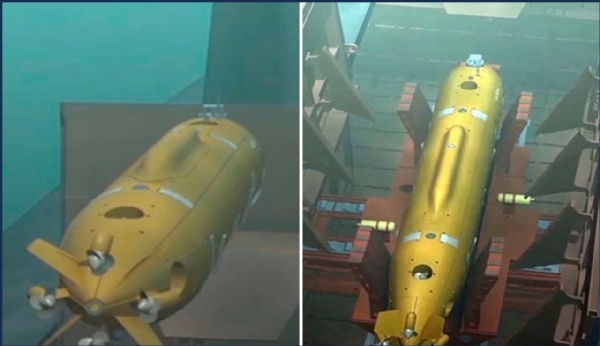Amidst Russia-Ukraine War, Russia plans first trials of nuclear-capable underwater drone ‘Poseidon’ in summer 2023
Total Views |
The first trials of the Poseidon nuclear-powered and nuclear-capable underwater drones from the Belgorod nuclear-powered submarine are expected for the summer of 2023, according to a source in the Russian media agency Sputnik.

The operation of Poseidon's reactor units will be examined first during the trials, according to the source, who also stated that the units have already undergone bench testing and that their safety and suitability for operation has been established.
The Poseidon underwater drone - also known as Status-6 and in the United States as "Kanyon" - is basically a very large, nuclear-powered autonomous torpedo armed with a nuclear warhead.
The project's goal was to "damage important components of the adversary's economy in a coastal area and inflict unacceptable damage to a country's territory by creating areas of widespread radioactive contamination that would be unsuitable for military, economic, or other activity for extended periods of time."
The torpedo, which Russia named Poseidon, is about 20 m long, can go 1,000 m deep and has a range of at least 10,000 km.
Much of its true capabilities are unknown, although one of its significant assets is supposed to be its capacity to operate very deep and very fast underwater, making it difficult to intercept.
Poseidon is described as a drone since it can navigate autonomously and may even be redirected or have its mission cancelled after it has been launched.
It is thought to feature a titanium hull that allows it to withstand pressure at deep depths and might be employed as a seabed weapon.
With a top speed of about 50 nautical miles per hour, or over 90 kilometres per hour, Poseidon would be twice as quick as a typical submarine and far more difficult to spot.
"It's a torpedo that has an extremely long range, can travel at high speeds, and then packs that nuclear punch," said David Hambling, a defence technology journalist who has written a book about drones.
According to Pavel Podvig, a specialist on Russian nuclear forces and senior researcher at the United Nations Institute for Disarmament Research (UNIDIR), what inspired its creation was Russia's desire to demonstrate a variety of missiles capable of evading the US missile defence system.
The Russian Navy's commander-in-chief, Adm. Nikolai Evmenov, told Sputnik on Thursday that the Belgorod submarine, built to carry Poseidon, will enter service in 2023.

The operation of Poseidon's reactor units will be examined first during the trials, according to the source, who also stated that the units have already undergone bench testing and that their safety and suitability for operation has been established.
The Poseidon underwater drone - also known as Status-6 and in the United States as "Kanyon" - is basically a very large, nuclear-powered autonomous torpedo armed with a nuclear warhead.
The project's goal was to "damage important components of the adversary's economy in a coastal area and inflict unacceptable damage to a country's territory by creating areas of widespread radioactive contamination that would be unsuitable for military, economic, or other activity for extended periods of time."
The torpedo, which Russia named Poseidon, is about 20 m long, can go 1,000 m deep and has a range of at least 10,000 km.
Much of its true capabilities are unknown, although one of its significant assets is supposed to be its capacity to operate very deep and very fast underwater, making it difficult to intercept.
Poseidon is described as a drone since it can navigate autonomously and may even be redirected or have its mission cancelled after it has been launched.
It is thought to feature a titanium hull that allows it to withstand pressure at deep depths and might be employed as a seabed weapon.
With a top speed of about 50 nautical miles per hour, or over 90 kilometres per hour, Poseidon would be twice as quick as a typical submarine and far more difficult to spot.
"It's a torpedo that has an extremely long range, can travel at high speeds, and then packs that nuclear punch," said David Hambling, a defence technology journalist who has written a book about drones.
According to Pavel Podvig, a specialist on Russian nuclear forces and senior researcher at the United Nations Institute for Disarmament Research (UNIDIR), what inspired its creation was Russia's desire to demonstrate a variety of missiles capable of evading the US missile defence system.


